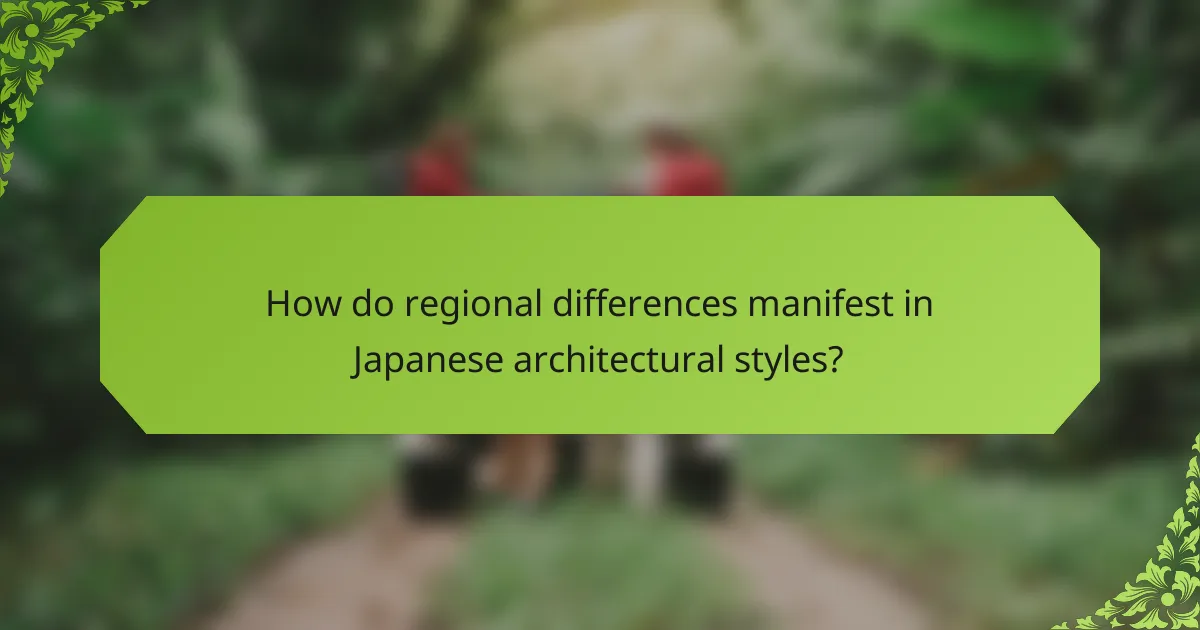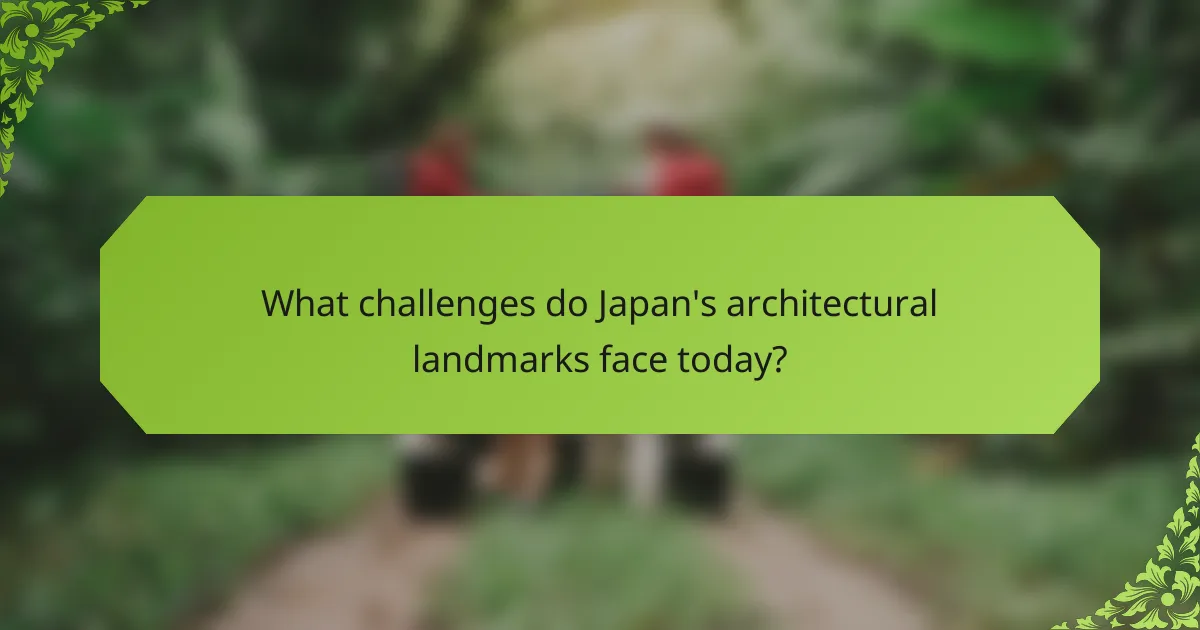Japan’s architectural wonders attract millions of tourists with their unique designs and historical significance. This article explores the evolution of Japanese architecture, highlighting key historical influences, iconic landmarks, and regional diversity. It also examines sustainable practices that enhance environmental harmony and the tourism appeal of these remarkable structures.

What are the defining features of Japan’s architectural wonders?
Japan’s architectural wonders are defined by their harmony with nature, innovative design, and rich historical significance. Traditional structures like shrines and temples showcase wooden construction and intricate details. Modern architecture blends technology with aesthetics, exemplified by iconic buildings like the Tokyo Skytree. These features attract millions of tourists, eager to experience Japan’s unique architectural landscape.
How do traditional Japanese design principles influence modern architecture?
Traditional Japanese design principles significantly influence modern architecture by emphasizing harmony with nature, simplicity, and spatial flow. These principles promote a seamless integration of indoor and outdoor spaces, often utilizing natural materials and minimalist aesthetics.
The concept of ‘Ma’, or negative space, is pivotal, encouraging thoughtful placement of elements to enhance the overall experience. Additionally, the use of traditional motifs and techniques, such as tatami mats and shoji screens, continues to inspire contemporary designs.
Modern architects often draw upon these elements to create structures that reflect cultural identity while meeting modern needs. This blend of tradition and innovation enhances the tourism appeal of Japan’s architectural landscape, attracting visitors interested in both historical and modern marvels.
What role do natural materials play in Japanese architecture?
Natural materials are essential in Japanese architecture, emphasizing harmony with nature. Wood, stone, and bamboo are commonly used, showcasing craftsmanship and sustainability. These materials create structures that blend seamlessly into their surroundings, reflecting Japan’s cultural values. Additionally, the use of tatami mats and shoji screens enhances interior aesthetics while promoting natural light and airflow. This approach not only preserves traditional techniques but also appeals to modern eco-conscious design sensibilities.

Which historical events shaped the evolution of architecture in Japan?
The evolution of architecture in Japan was shaped by significant historical events such as the introduction of Buddhism in the 6th century, which influenced temple design. The Heian period (794-1185) saw the development of the unique Japanese aesthetic in residential architecture. The Edo period (1603-1868) introduced urban planning and the use of natural materials. The Meiji Restoration (1868) brought Western architectural styles, leading to a fusion of traditional and modern elements. Each of these events contributed to Japan’s architectural identity, reflecting cultural shifts and technological advancements.
How did the Meiji Restoration impact architectural styles?
The Meiji Restoration significantly transformed architectural styles in Japan, merging Western influences with traditional aesthetics. This period marked the introduction of Western building techniques and materials, leading to a unique architectural fusion. Notable structures like the Tokyo Station exemplify this blend, showcasing brick and stone alongside traditional Japanese elements. The shift also reflected Japan’s modernization efforts, impacting urban planning and public buildings, which aimed to project a new national identity. As a result, contemporary Japanese architecture continues to reflect this rich historical context, appealing to both domestic and international tourism.
What influences did Western architecture bring to Japan?
Western architecture significantly influenced Japan through the introduction of new design elements and construction techniques. Key influences include the adoption of Western-style buildings, such as banks and government offices, which began in the Meiji period. This era marked a shift from traditional Japanese wooden structures to brick and stone designs, showcasing a blend of Western and Japanese aesthetics.
The incorporation of elements like large windows, high ceilings, and open spaces transformed urban landscapes. Notably, iconic structures such as the Tokyo Station and the National Diet Building exemplify this fusion. The influence also extended to interior design, where Western furniture and layouts became popular, enhancing functionality and comfort.
Tourism has benefited from these architectural wonders, drawing visitors to experience the unique blend of cultures. This architectural evolution reflects Japan’s adaptability and willingness to embrace change while preserving its cultural identity.
![]()
What are the most iconic architectural landmarks in Japan?
Japan is home to many iconic architectural landmarks that showcase its rich history and unique design elements. Notable examples include the ancient Himeji Castle, renowned for its elegant white facade and intricate wooden construction. The Tokyo Skytree stands as a modern marvel, reaching 634 meters and attracting millions of visitors annually. Kyoto’s Kinkaku-ji, the Golden Pavilion, exemplifies traditional Japanese architecture with its stunning gold leaf exterior and serene gardens. The Great Buddha of Nara, a monumental bronze statue, reflects Japan’s Buddhist heritage. Each landmark offers a glimpse into Japan’s cultural evolution and architectural ingenuity.
How does Kyoto’s historical architecture reflect cultural heritage?
Kyoto’s historical architecture showcases cultural heritage through its traditional wooden structures, ornate temples, and meticulous gardens. These elements reflect Japan’s aesthetic values, spirituality, and connection to nature. For example, the Kinkaku-ji, or Golden Pavilion, exemplifies the unique attribute of incorporating natural surroundings into design, enhancing its spiritual significance. The preservation of these architectural wonders attracts millions of tourists, underscoring their importance in Japan’s cultural narrative.
What makes the Tokyo Skytree a modern architectural marvel?
The Tokyo Skytree is a modern architectural marvel due to its innovative design, height, and cultural significance. Standing at 634 meters, it is the tallest structure in Japan and the second tallest in the world. Its design blends traditional Japanese aesthetics with cutting-edge technology, featuring a unique asymmetrical shape that enhances stability against earthquakes. The Skytree serves as a broadcasting tower and a major tourist attraction, offering panoramic views of Tokyo. Its construction utilized advanced materials and techniques, showcasing Japan’s engineering prowess.

How do regional differences manifest in Japanese architectural styles?
Regional differences in Japanese architectural styles manifest through variations in materials, design principles, and cultural influences. For instance, traditional wooden structures in rural areas contrast with modern urban designs.
Regional climates influence materials; thatched roofs are common in snowy regions, while coastal areas favor stilted designs for flood protection. Cultural heritage also plays a role, with Shinto shrines showcasing distinct aesthetics compared to Buddhist temples.
Additionally, the use of space varies; urban architecture emphasizes efficiency, while rural designs often prioritize harmony with nature. These factors create a rich tapestry of architectural diversity across Japan.
What are the unique characteristics of Okinawan architecture?
Okinawan architecture is characterized by unique features that reflect its cultural heritage and environmental adaptation. Key characteristics include the use of red-tiled roofs, wooden structures, and open spaces that promote airflow. The design often incorporates elements of nature, with gardens and courtyards integrated into the layout. Additionally, the use of limestone and coral in construction showcases local materials. These attributes distinguish Okinawan architecture from other Japanese styles, emphasizing harmony with the surrounding environment and community living.
How does Hokkaido architecture adapt to its climate?
Hokkaido architecture adapts to its climate by incorporating features that enhance insulation and durability. The use of thick walls and sloped roofs helps manage heavy snowfall. Traditional materials, such as wood, provide natural insulation and resilience against cold temperatures. Additionally, large windows maximize sunlight exposure during long winters, promoting warmth and reducing energy costs. These design elements reflect a unique adaptation to Hokkaido’s harsh climate conditions.

What is the significance of sustainable practices in Japanese architecture?
Sustainable practices in Japanese architecture significantly enhance environmental harmony and cultural preservation. These practices prioritize natural materials, energy efficiency, and integration with the surrounding landscape. Traditional techniques, such as using wooden structures and tatami mats, promote sustainability by being renewable and biodegradable. The emphasis on minimalism also fosters a connection to nature, reflecting a unique attribute of Japanese design. As a result, sustainable architecture in Japan attracts tourism, showcasing a commitment to ecological balance and historical heritage.
How are traditional techniques being integrated into contemporary designs?
Traditional techniques are increasingly integrated into contemporary designs in Japan, enhancing architectural aesthetics and cultural significance. This fusion often includes the use of natural materials, such as wood and stone, which reflect Japan’s historical craftsmanship. For instance, modern buildings may incorporate traditional tatami layouts or sliding shoji screens, promoting harmony with nature.
Additionally, contemporary architects often draw inspiration from historical forms, such as pagodas and castles, blending them with modern functionality. This approach not only preserves cultural heritage but also appeals to tourists seeking authentic experiences. The unique attribute of this integration is the balance between innovation and tradition, creating spaces that resonate with both historical context and modern needs.
As a result, Japan’s architectural landscape showcases a seamless dialogue between the past and present, attracting visitors and inspiring future designs.
What are the benefits of biophilic design in Japanese buildings?
Biophilic design in Japanese buildings enhances well-being, promotes sustainability, and fosters a connection with nature. This design approach integrates natural elements, improving mental health and productivity. For example, incorporating greenery and natural light creates calming environments. Additionally, biophilic design supports energy efficiency, aligning with Japan’s commitment to sustainable architecture. This holistic approach distinguishes Japanese architecture by merging tradition with modern environmental practices.

How do architectural wonders influence tourism in Japan?
Architectural wonders significantly enhance tourism in Japan by attracting visitors with their unique designs and historical significance. Structures like the ancient temples, modern skyscrapers, and traditional castles showcase Japan’s rich cultural heritage and innovative spirit.
The iconic Kinkaku-ji, or Golden Pavilion, draws tourists for its stunning reflection on the surrounding pond, embodying the unique attribute of Zen architecture. Meanwhile, Tokyo Skytree, the tallest structure in Japan, offers breathtaking city views, appealing to those seeking modern marvels.
Cultural events and festivals often take place near these architectural sites, further boosting tourism. For instance, the cherry blossom season at Himeji Castle attracts thousands, illustrating the rare attribute of seasonal appeal.
Overall, Japan’s architectural diversity not only represents its historical context but also serves as a powerful magnet for international travelers.
What are the most popular architectural sites for international tourists?
Japan is home to many architectural wonders that attract international tourists. Notable sites include the historic Himeji Castle, recognized for its stunning white exterior and intricate design, and the modern Tokyo Skytree, which stands as the tallest structure in Japan at 634 meters. Other significant sites are the ancient temples of Kyoto, such as Kinkaku-ji, known for its golden pavilion, and the innovative National Museum of Emerging Science and Innovation in Tokyo. These architectural marvels showcase a blend of traditional and contemporary design, enhancing Japan’s tourism appeal.
How does architecture enhance the visitor experience in Japan?
Architecture enhances the visitor experience in Japan through its unique blend of historical significance, aesthetic appeal, and cultural integration. Iconic structures like Kyoto’s Kinkaku-ji and Tokyo’s Skytree offer immersive experiences that reflect Japan’s heritage. Visitors engage with traditional design elements, such as tatami mats and sliding doors, which encourage harmony with nature. Additionally, contemporary architectural marvels showcase innovative technology while respecting the environment. This balance creates a memorable journey, allowing tourists to appreciate both past and present in Japan’s architectural landscape.

What challenges do Japan’s architectural landmarks face today?
Japan’s architectural landmarks face challenges such as urbanization, natural disasters, and preservation issues. Urban expansion threatens historical sites, leading to potential loss of cultural heritage. Natural disasters like earthquakes and typhoons pose risks, requiring innovative engineering solutions. Preservation efforts often struggle against modernization demands, complicating maintenance of traditional aesthetics. Additionally, tourism fluctuations impact funding for restoration projects, affecting long-term sustainability.
How is preservation of historical sites addressed in urban planning?
Preservation of historical sites in urban planning involves integrating these sites into development strategies. This ensures cultural heritage is maintained while accommodating modern needs. Effective urban planning employs zoning laws, financial incentives, and community engagement to protect architectural wonders. For instance, Japan’s approach often emphasizes the balance between tourism appeal and historical integrity.
What are the impacts of natural disasters on architectural integrity?
Natural disasters significantly impact architectural integrity by causing structural damage and weakening foundations. In Japan, historical structures like temples and castles face challenges from earthquakes and typhoons. These events can lead to costly repairs and loss of cultural heritage. Moreover, innovative design elements, such as seismic isolation techniques, enhance resilience against such disasters, ensuring these architectural wonders remain safe for tourism and preservation.
What strategies can be employed to ensure sustainable tourism?
Implementing sustainable tourism in Japan’s architectural wonders involves several strategies. Prioritizing eco-friendly practices, such as using renewable materials in restoration, enhances both preservation and visitor experience. Engaging local communities fosters authentic cultural exchanges, promoting respect for heritage. Additionally, limiting tourist numbers at sensitive sites helps mitigate environmental impact and preserves the integrity of historical structures. Finally, promoting educational programs on sustainability can raise awareness among tourists, encouraging responsible behavior during their visits.
What best practices should be followed when visiting Japan’s architectural sites?
When visiting Japan’s architectural sites, respect local customs and preservation efforts. Prioritize guided tours to gain insights into historical context and design elements.
1. Follow signage and guidelines to protect structures.
2. Engage with local guides for authentic experiences.
3. Visit during off-peak hours for a more intimate exploration.
4. Consider the cultural significance of each site.
5. Take photographs respectfully, avoiding disruption.



